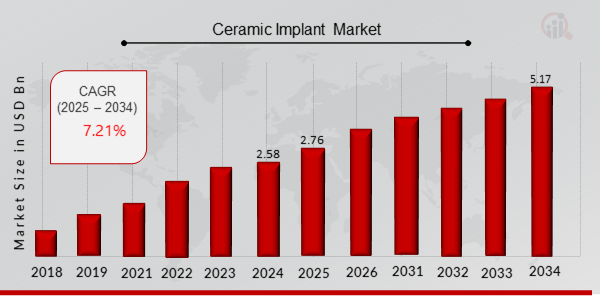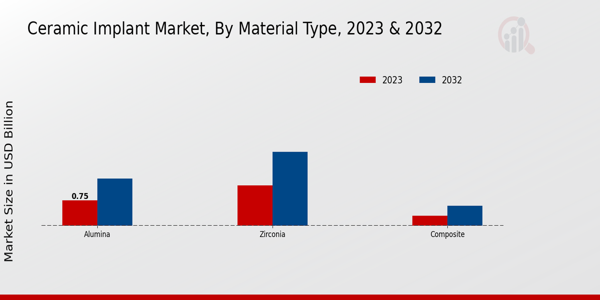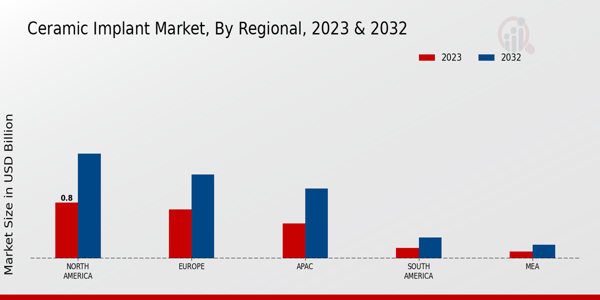Ceramic Implant Market Overview
As per MRFR analysis, the Ceramic Implant Market Size was estimated at 2.58 (USD Billion) in 2024. The Ceramic Implant Market Industry is expected to grow from 2.76 (USD Billion) in 2025 to 5.17 (USD Billion) till 2034, at a CAGR (growth rate) is expected to be around 7.21% during the forecast period (2025 - 2034).
Key Ceramic Implant Market Trends Highlighted
The Ceramic Implant Market is experiencing significant growth driven by increasing demand for advanced dental and orthopedic solutions. Factors such as the rise in dental tourism, the growing awareness of oral hygiene, and advancements in technology significantly contribute to market expansion. The preference for ceramic implants over traditional metal implants due to their biocompatibility and aesthetic appeal is reshaping consumer choices. Additionally, an aging population and the subsequent rise in dental and orthopedic procedures further fuel the demand for ceramic implants. There are numerous opportunities to be explored within the market, particularly in emerging regions where healthcare infrastructure is improving.Manufacturers can focus on developing innovative products that cater to specific patient needs, such as custom-made ceramic implants. Collaborations and partnerships between research institutions and manufacturers can also drive innovation, allowing for the creation of more effective and durable implants.
Furthermore, education and awareness campaigns can enhance consumer understanding of the benefits of ceramic implants, potentially increasing market penetration. Recent trends include a growing emphasis on minimally invasive procedures which align with the consumer preference for quicker recovery times and less discomfort. The shift towards digital dentistry is notable, especially with the integration of 3D printing technologies in implant production.This allows for more precise and personalized implant designs. Sustainability is also becoming crucial as environmentally friendly materials and practices are increasingly prioritized. As healthcare professionals continue to adopt advanced solutions, the market is poised to evolve rapidly, meeting the changing needs of patients in a dynamic landscape.

Source: Primary Research, Secondary Research, MRFR Database and Analyst Review
Ceramic Implant Market Drivers
Increasing Demand for Biocompatible Materials
The Ceramic Implant Market Industry is observing increased demand and valuation in the market due to the growing requirement for biocompatible materials. As with implants, biocompatibility is essential in the medical field as it defines interactions of the body with foreign substances. With the rise of various health disorders and the aging population, there is a higher need for implants that do not provoke a negative biological response. Ceramic implants, known for their excellent biocompatibility properties, are increasingly being favored over traditional materials.Additionally, advancements in ceramic technology have led to the development of implants that better mimic the properties of natural bone, resulting in improved integration and reduced complication rates. Physicians and patients alike are increasingly aware of the benefits posed by such materials, further propelling demand. As healthcare providers seek to enhance patient outcomes through the use of innovative implant solutions, biocompatibility stands out as one of the most significant drivers of growth in the Ceramic Implant Market.
Technological Advancements in Implant Design
Technological advancements in implant design are set to propel the Ceramic Implant Market Industry forward. Innovations related to 3D printing, advanced surface treatments, and enhanced material formulations are leading to better performance and customization of implants. As surgical techniques evolve and recoveries become faster, the demand for high-quality, accurately designed ceramic implants is rising, making technology a key driver of market dynamics.
Growing Acceptance of Dental Ceramic Implants
There is a growing acceptance of dental ceramic implants in the Ceramic Implant Market Industry, attributed to the aesthetic and functional benefits they offer. Patients increasingly prefer ceramic options over metal implants due to issues related to aesthetics, allergic reactions, and corrosion concerns. This heightened acceptance leads to higher demand within the dental sector, significantly influencing market growth.
Ceramic Implant Market Segment Insights
Ceramic Implant Market Material Type Insights
In the Ceramic Implant Market, the Material Type segment plays a pivotal role in determining the direction and growth of the industry. As of 2023, the overall market is valued at 2.25 USD Billion, highlighting a robust sector characterized by evolving materials and technological advancements. Delving deeper into the Material Type segmentation, we note that Alumina commands a significant share, valued at 0.75 USD Billion in 2023 and is expected to reach 1.4 USD Billion by 2032. The significance of Alumina can be attributed to its excellent biocompatibility and wear resistance, making it a preferred choice for various implant applications.Following closely is Zirconia, a dominant force in the market valued at 1.2 USD Billion in 2023 and projected to grow to 2.2 USD Billion by 2032. Zirconia's superiority is demonstrated by its high strength, esthetic appeal, and ability to endure the biological environment of the human body, establishing it as a trusted material among professionals.
Lastly, the Composite segment, while smaller, holds a value of 0.3 USD Billion in 2023 and is projected to grow to 0.6 USD Billion by 2032. Though it has the least market holding compared to Alumina and Zirconia, Composite materials are gaining traction owing to their customizable properties and potential for enhanced functionality, allowing for innovative applications.The trends in the Ceramic Implant Market reveal strong growth drivers, such as the increasing elderly population, rising demand for dental implants, and advances in material science, which facilitate the adoption of advanced ceramic implants. However, challenges such as high manufacturing costs and stringent regulatory compliance continue to affect market dynamics. The interplay of these materials within the ceramic implant space, coupled with evolving technology, presents new opportunities for growth and market expansion. The overall importance of this segment cannot be understated, as Material Type strongly influences the performance and acceptance of ceramic implants in clinical settings, ultimately contributing to the expansive Ceramic Implant Market revenue that is expected to reach 4.2 USD Billion by 2032.

Source: Primary Research, Secondary Research, MRFR Database and Analyst Review
Ceramic Implant Market Application Insights
Within the Application segment, the market encompasses crucial areas such as dental implants, orthopedic implants and maxillofacial implants. Dental implants have emerged as a significant focus area due to the increasing prevalence of dental disorders and the rising demand for aesthetic solutions, contributing to substantial market growth. Orthopedic implants are equally important as the aging population and the rising incidence of bone-related disorders necessitate effective surgical interventions.Furthermore, maxillofacial implants play a pivotal role in reconstructive surgery, addressing trauma and congenital issues, which underscores their critical value in the healthcare industry. The continued investments in research and development, combined with an increasing number of minimally invasive procedures, are expected to further enhance the market dynamics. Overall, the Ceramic Implant Market segmentation highlights the importance of these applications in meeting the diverse needs of patients and healthcare providers, significantly contributing to the overall market statistics and growth trajectory.
Ceramic Implant Market End User Insights
The Ceramic Implant Market is evolving significantly, with its segmentation by End Users revealing valuable insights. Hospitals play a critical role in the market due to their extensive ability to provide a wide range of ceramic implants, thereby meeting the healthcare needs of patients with complex conditions. Dental Clinics represent a significant portion of this segment as the demand for dental implants increases among individuals seeking cosmetic and functional improvements.Orthopedic Clinics also contribute substantially to the market, primarily driven by an increasing prevalence of orthopedic conditions that necessitate the use of ceramic implants for effective treatment options. With the Ceramic Implant Market showing growth driven by factors such as technological advancements and rising awareness of implant benefits, the segmentation data reflects ongoing trends that will play an essential role in strategizing for future market expansion and innovation. The Ceramic Implant Market statistics suggest a promising trajectory as the industry adapts to dynamic healthcare demands.
Ceramic Implant Market Distribution Channel Insights
The Distribution Channel segment of the Ceramic Implant Market plays a crucial role in shaping the accessibility and reach of ceramic implants. Direct Sales are vital as they provide personalized service and direct interaction between manufacturers and healthcare providers, facilitating trust and immediate resolution of queries. Online Sales have gained traction, particularly during the digital shift, providing an efficient platform for customers to access various products conveniently.Distributors are also significant in this market, as they help in the wide dissemination of ceramic implants across different regions, ensuring availability and supporting logistics. The continuous evolution of these distribution channels reflects the increasing demand for ceramic implants, influenced by trends such as digitalization in healthcare and the rising inclination toward minimally invasive procedures. As the market expands, leveraging these channels effectively will be essential for sustaining growth and enhancing customer satisfaction in the Ceramic Implant Market industry.Market participants must adapt to any emerging challenges and seize opportunities within these distribution channels to capitalize on market growth.
Ceramic Implant Market Regional Insights
North America holds the largest share, valued at 0.8 billion in 2023, reflecting its majority holding in market dynamics due to advanced healthcare infrastructure and high demand for dental and orthopedic solutions. Europe closely follows with a valuation of 0.7 billion in 2023, benefiting from a strong emphasis on research and development in ceramic materials. The APAC region, valued at 0.5 billion in 2023, is emerging significantly due to expanding healthcare access and rising dental care awareness.South America and MEA are smaller markets, valued at 0.15 billion and 0.1 billion, respectively, in 2023, showing growth potential as awareness of ceramic implants improves. This diversity in the Ceramic Implant Market segmentation highlights varying healthcare needs and technological advancements, creating distinct opportunities and challenges across regions, which significantly influence market growth and dynamics.

Source: Primary Researc, Secondary Research, MRFR Database and Analyst Review
Ceramic Implant Market Key Players and Competitive Insights
The Ceramic Implant Market has been experiencing significant growth, driven by increasing demand for dental implants and the rising awareness of the advantages of using ceramic materials over traditional metal implants. As the market evolves, competitive insights reveal a diverse landscape characterized by the presence of key players who specialize in innovative solutions aimed at enhancing patient outcomes. The emphasis on biocompatibility, aesthetic appeal, and long-term performance has spurred competition, leading companies to invest in research and development as well as marketing strategies to capture a larger share of this lucrative market. Moreover, the growing inclination towards minimally invasive procedures and the increasing prevalence of dental disorders have further fueled the expansion of the ceramic implant sector, prompting manufacturers to refine their product offerings and improve operational efficiencies.Institut Straumann AG has established a strong presence within the Ceramic Implant Market through its commitment to high-quality products and cutting-edge technology.
The company has distinguished itself by leveraging advanced manufacturing processes and a focus on unique material properties that enhance the functionality and aesthetics of ceramic implants. Its extensive portfolio of offerings, including a wide array of implant solutions tailored to meet diverse clinical needs, underlines its strength in catering to various patient profiles. Furthermore, Institut Straumann AG has built a significant reputation for investing in collaborative partnerships with dental professionals and research institutions, thereby ensuring it remains at the forefront of innovation in this competitive landscape. The company’s dedication to continuous improvement and customer education has further cemented its status as a leader in the ceramic implant domain.Sicam has emerged as a notable contender in the Ceramic Implant Market, focusing on comprehensive solutions that emphasize both quality and performance.
The company prides itself on its robust product lineup, which includes various ceramic implants designed to meet the demands of modern dentistry. Sicam's strength lies in its ability to offer competitive pricing without compromising on the quality of materials used, making it an attractive choice for dental professionals looking for reliable and effective solutions. Additionally, Sicam’s commitment to innovation is evident in its ongoing research efforts aimed at enhancing the properties of its ceramic implants, ensuring they meet the evolving needs of practitioners and patients alike. The company consistently seeks to strengthen its market presence through strategic marketing initiatives and partnerships, positioning itself as a key player in the expanding ceramic implant sector while focusing on customer satisfaction and product reliability.
Key Companies in the Ceramic Implant Market Include:
- Institut Straumann AG
- Sicam
- Nobel Biocare
- Biomerics
- Kyocera Medical
- Zystems
- Osstem Implant
- Kerix
- Hiossen
- Zirconia Dental Implants
- CeramTec
- Camlog
- Straumann
- Dentsply Sirona
Ceramic Implant Market Industry Developments
Recent developments in the Ceramic Implant Market highlight a growing focus on innovative materials and technological advancements aimed at improving implant performance and patient outcomes. Companies like Institut Straumann AG and Nobel Biocare continue to lead in research and development, focusing on the enhancement of zirconia implants due to their aesthetic appeal and superior biocompatibility.
Recent market trends indicate a substantial rise in the demand for ceramic implants, particularly in cosmetic dentistry, driven by consumer preference for non-metallic options. Additionally, Biomerics is gaining attention for its expanding portfolio of custom ceramic implants tailored to meet diverse clinical needs. Merger and acquisition activity has been evident, with firms like Dentsply Sirona exploring strategic partnerships to bolster their market presence, reflecting the competitive nature of the industry. Kyocera Medical’s recent collaborations also indicate a strategic move to enhance its market reach. As a result, the overall market valuation is projected to grow significantly, fueled by advancements in technology and increasing acceptance of ceramic implants among dental professionals and patients alike.
Ceramic Implant Market Segmentation Insights
Ceramic Implant Market Material Type Outlook
- Alumina
- Zirconia
- Composite
Ceramic Implant Market Application Outlook
- Dental Implants
- Orthopedic Implants
- Maxillofacial Implants
Ceramic Implant Market End User Outlook
- Hospitals
- Dental Clinics
- Orthopedic Clinics
Ceramic Implant Market Distribution Channel Outlook
- Direct Sales
- Online Sales
- Distributors
Ceramic Implant Market Regional Outlook
- North America
- Europe
- South America
- Asia Pacific
- Middle East and Africa
| Report Attribute/Metric |
Details |
|
Market Size 2024
|
2.58 (USD Billion)
|
|
Market Size 2025
|
2.76 (USD Billion)
|
|
Market Size 2034
|
5.17 (USD Billion)
|
|
Compound Annual Growth Rate (CAGR)
|
7.21 % (2025 - 2034)
|
|
Report Coverage
|
Revenue Forecast, Competitive Landscape, Growth Factors, and Trends
|
|
Base Year
|
2024
|
|
Market Forecast Period
|
2025 - 2034
|
|
Historical Data
|
2020 - 2024
|
| Market Forecast Units |
USD Billion |
| Key Companies Profiled |
Institut Straumann AG, Sicam, Nobel Biocare, Biomerics, Kyocera Medical, Zystems, Osstem Implant, Kerix, Hiossen, Zirconia Dental Implants, CeramTec, Camlog, Straumann, Dentsply Sirona |
| Segments Covered |
Material Type, Application, End User, Distribution Channel, Regional |
| Key Market Opportunities |
1. Increasing demand for biocompatible materials, 2. Growth in dental implant procedures, 3. Rising prevalence of orthodontic issues, 4. Technological advancements in implant design, 5. Expanding applications in orthopedic surgeries |
| Key Market Dynamics |
1. Increasing demand for biocompatibility, 2. Rising prevalence of dental disorders, 3. Advancements in manufacturing technologies, 4. Growing awareness of aesthetic treatments, 5. Expanding geriatric population. |
| Countries Covered |
North America, Europe, APAC, South America, MEA |
Frequently Asked Questions (FAQ) :
The Ceramic Implant Market is expected to be valued at 4.2 USD Billion in 2034.
The expected CAGR for the Ceramic Implant Market from 2025 to 2034 is 7.21%.
North America is projected to have the largest market size at 1.5 USD Billion in 2034.
The Ceramic Implant Market for the Alumina segment is valued at 1.4 USD Billion in 2034.
The market size for the Zirconia segment is expected to reach 2.2 USD Billion in 2034.
Key players include Institut Straumann AG, Nobel Biocare, and Dentsply Sirona, among others.
The expected market value of the Composite segment in 2034 is 0.6 USD Billion.
The market size for the Ceramic Implant Market in Europe is projected to be 1.2 USD Billion in 2034.
The Ceramic Implant Market in the APAC region is expected to be worth 1.0 USD Billion in 2034.
Growth drivers include increasing demand for dental implants and advancements in ceramic materials.

















